Related Research Articles

Agha Mohammad Khan Qajar, also known by his regnal name of Agha Mohammad Shah, was the founder of the Qajar dynasty of Iran, ruling from 1789 to 1797 as Shah. Originally a chieftain of the Quwanlu branch of the Qajar tribe, Agha Mohammad Khan was enthroned as the king of Iran in 1789, but was not officially crowned until March 1796, having deposed Lotf Ali Khan of the Zand dynasty in 1794.
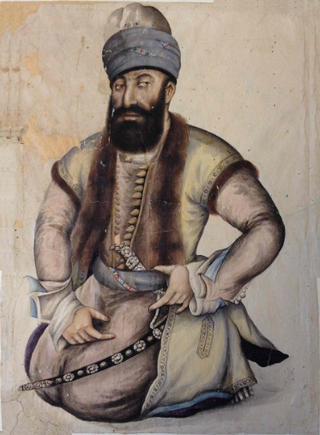
Mohammad Karim Khan Zand was the founder of the Zand dynasty, ruling all of Iran (Persia) except for Khorasan from 1751 to 1779. He also ruled over some of the Caucasian lands and occupied Basra for some years.

Qashqai people are a Turkic tribal confederation in Iran. Almost all of them speak a Western Turkic (Oghuz) language known as the Qashqai language – which they call "Turkī" – as well as Persian in formal use. The Qashqai mainly live in the provinces of Fars, Khuzestan, Kohgiluyeh and Boyer-Ahmad, Chaharmahal and Bakhtiari, Bushehr and southern Isfahan, especially around the cities of Shiraz and Firuzabad in Fars.
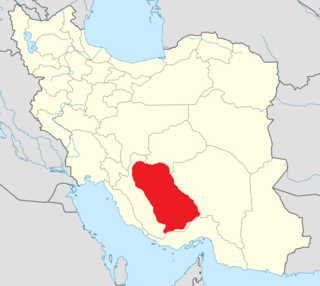
The Khamseh is a tribal confederation in the province of Fars in southwestern Iran. It consists of five tribes, hence its name Khamseh, "the five". The tribes are partly nomadic, Some are Persian speaking Basseri, some are Arabic speaking Arabs, and some are Qashqai Language speaking. They are sheep breeders, which they herd mounted on camels.

A Shiraz carpet is a type of Persian rug made in the villages around the city of Shiraz, in the Iranian province of Fars.

Sardar Asaad Bakhtiari, also known as Haj Ali-Gholi Khan, Sardar Asaad II was an Iranian revolutionary and a chieftain of the Bakhtiari Haft Lang tribe. The third son of Hossein Gholi Khan Ilkhani, he was one of the primary figures of the Persian Constitutional Revolution. He was the brother of Najaf-Qoli Khan Bakhtiari Samsam Ol-Saltaneh, Bibi Maryam Bakhtiari Sardar Bibi, and Khorou Khan Bakhtiari Sardar Zafar.

The Anglo-Persian War, also known as the Anglo-Iranian War, was a war fought between the United Kingdom and Iran, which was ruled by the Qajar dynasty. The war had the British oppose an attempt by Iran to press its claim on the city of Herat. Though Herat had been part of Iran under the Qajar dynasty when the war broke out, it had declared itself independent under its own rebellious emir and placed itself under the protection of the British in India and in alliance with the Emirate of Kabul, the predecessor of the modern state of Afghanistan. The British campaign was successfully conducted under the leadership of Major General Sir James Outram in two theatres: on the southern coast of Iran near Bushehr and in southern Mesopotamia.

The Basseri are a Persian nomadic and pastoral tribe of the Fars province in Iran. Their migratory area is around Shiraz. They are one of the five tribes of the larger Khamseh confederation. The "tent" is the basic unit of social organization among the Basseri. All tents have a recognized head that deals with the formal officers of the tribe, villagers, and other strangers. The Basseri economy stems mainly from sheep and goats.

The Persian campaign or invasion of Iran was a series of military conflicts between the Ottoman Empire, British Empire and Russian Empire in various areas of what was then neutral Qajar Iran, beginning in December 1914 and ending with the Armistice of Mudros on 30 October 1918, as part of the Middle Eastern Theatre of World War I. The fighting also involved local Persian units, who fought against the Entente and Ottoman forces in Iran. The conflict proved to be a devastating experience for Persia. Over 2 million Persian civilians died in the conflict, mostly due to the Armenian genocide by the Ottoman regime and Persian famine of 1917–1919, influenced by British and Russian actions. The Qajar government's inability to maintain the country's sovereignty during and immediately after the First World War led to a coup d'état in 1921 and Reza Shah's establishment of the Pahlavi dynasty.

Mohammad Bahmanbeigi, sometimes rendered Mohammad Bahman Beigi, was an activist of education for nomadic communities in Iran.
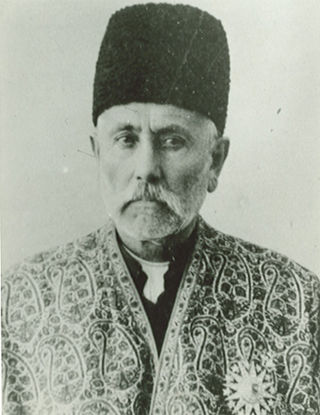
Najaf-Qoli Khan Bakhtiari also known as Saad al-Dowleh and Samsam al-Saltane (1846–1930), was a Persian Prime Minister and a leader of the Iranian Constitutional Revolution. He was elected Prime Minister for two terms, first from 3 May 1909 to 16 July 1909 and again from 23 December 1912 to 17 January 1913, when he resigned from the office. He was a representative of Parliament of Iran from Tehran in the 4th Parliament. He was the older brother of Ali-Qoli Khan Bakhtiari, better known as Sardar Assad, Bibi Maryam Bakhtiari and Khosrou Khan, Sardar Zafar Bakhtiari. He died in 1930 in Isfahan.
1921 Persian coup d'état, known in Iran as 3 Esfand 1299 coup d'état, refers to several major events in Qajar Persia in 1921, which eventually led to the deposition of the Qajar dynasty and the establishment of the Pahlavi dynasty as the ruling house of Iran in 1925.

Rais-Ali Delvari was an Iranian military leader. He is remembered as a national hero in Iran who organized popular resistance against British forces after the invasion of Iran in 1915.
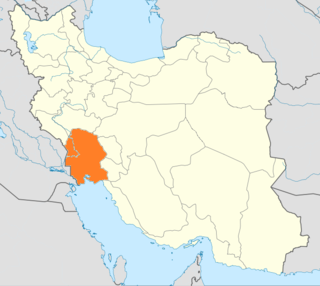
The 1979 Khuzestan uprising was one of the nationwide uprisings in Iran, which erupted in the aftermath of the Iranian revolution. The unrest was fed by Arab demands for autonomy. The uprising was effectively quelled by Iranian security forces, resulting in more than a hundred people on both sides killed.

The Sheikh Khazal rebellion refers to the 1924 Arab separatist uprising by Khazal al-Kabi, the Sheikh of Muhammara, in Iranian Khuzestan. The rebellion was quickly and efficiently suppressed by Reza Shah with minimal casualties, subduing the Bakhtiari tribes allied with Sheikh Khazal and resulting in his surrender and the end of Arab autonomy in Khuzestan.

Hajji Ebrahim Shirazi, also known by his honorific title E'temad ol-Dowleh, was an Iranian statesman who served as the kalantar of the city of Shiraz during the late Zand era and later as the first grand vizier of Qajar Iran.
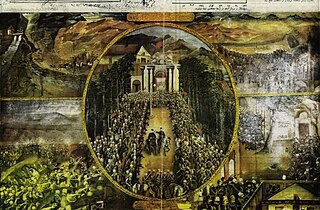
The Triumph of Tehran refers to the entrance of the pro-constitutionalists in Tehran on 13 July 1909, which led Mohammad Ali Shah Qajar to seek refuge at the Russian legation in Tehran, before he was sent in exile. The event ended the period in Iranian history known as the minor tyranny.
Ali Mardan Khan Bakhtiari was the Bakhtiari supreme chieftain (ilkhani) of the Chahar Lang branch, and major contender for supremacy in western Iran after the death of Nader Shah in 1747.
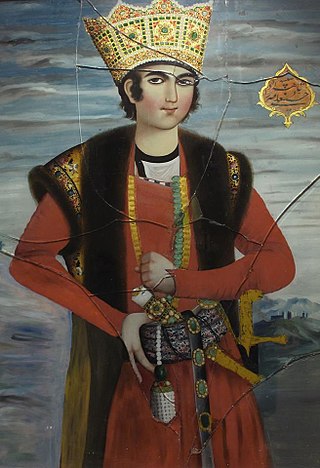
Hossein Ali Mirza, a son of Fath-Ali Shah, was the Governor of Fars and pretender to the throne of Qajar Iran.

Ali Akbar Qavam ol-Molk was an Iranian statesman who served as the kalantar of Shiraz and Custodian of Astan Quds Razavi in the Qajar era. He was the youngest son of Hajji Ebrahim Shirazi, the grand vizier of Fath-Ali Shah Qajar who by the latter's order was executed, his family too, subsequently purged. Ali Akbar was one of the survivors. Later for appeasement by the orders of Fath-Ali Shah, his family lands were returned and he became the kalantar of Shiraz, thus marking the start of Qavam family.
References
- 1 2 3 4 Burrell, Robert Michael; Jarman, Robert L. (1997). Iran: 1943-1945. Archive Editions. p. 467. ISBN 978-1-85207-710-5.
- 1 2 3 4 5 6 Cronin, Stephanie (2007-01-24). Tribal Politics in Iran: Rural Conflict and the New State, 1921-1941. Routledge. pp. 120, 121, 122, 123, 124, 125. ISBN 978-1-134-13801-2.